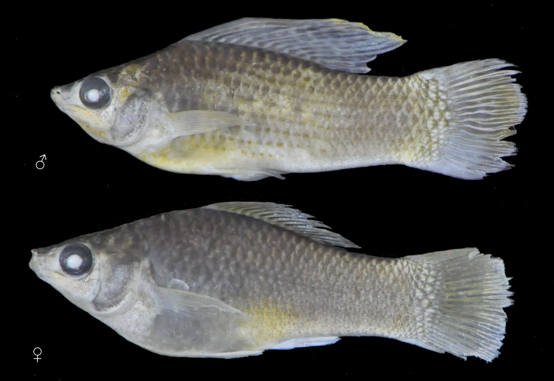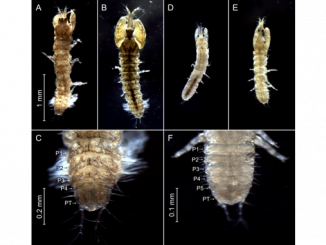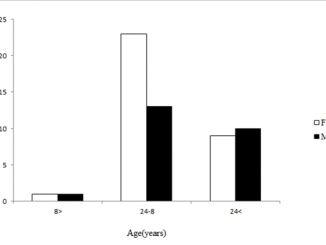
Paper category: Original research paper
Corresponding author: Salim Serkan Güçlü (salimguclu@isparta.edu.tr)
DOI: 10.2478/oandhs-2021-0023
Received: 16/02/2021
Accepted: 02/04/2021
Full text: here
Citation (APA style): Güçlü,S.,Al Jufaili,S. & Jawad,L.(2021).Growth parameters of Poecilia latipinna (Lesueur, 1821) (Actinopterygii, Poeciilidae) – an introduced species in brackish water of Wadi Al-Bahayes (Oman). Oceanological and Hydrobiological Studies,50(3) 269-277. https://doi.org/10.2478/oandhs-2021-0023
Abstract
This work is one of the first studies on the growth of Poecilia latipinna outside its natural habitat. The objective of our study was to investigate the growth parameters of the population of P. latipinna, which is an alien species in Oman (Wadi Al-Bahayes). The population structure of P. latipinna in Wadi Al-Bahayes (Oman; 23°40’47”N; 58°11’36”E) was studied in June and August 2020, using 124 fish. In the course of this study, the number of individuals of each sex, age, weight and size composition were determined. In addition, the total length–weight relationship (LRW) was calculated, as well as the von Bertalanffy growth equation. The mean growth performance (phi prime) and the condition factor were calculated. Males accounted for 37.10% and females for 62.90% of the population. The length–weight relationship and the von Bertalanffy growth equation were W = 0.0214 × L<sup> 2.7889</sup> R<sup> 2</sup> = 0.9212, Lt = 11.46 (1 − e<sup> −0.127 (t + 2.71)</sup>) for males and Lt = 14.51 (1 − e<sup>−0.072 (t + 3.98)</sup>) for females. The mean growth performance and the condition factor were calculated as 1.22 for males and 1.18 for females and 1.54 for all specimens. The study shows that the population of the species is characterized by a wide age range. Consequently, monitoring of this alien species is highly recommended.
Acknowledgements
This project was funded by Geo-Resources Environmental and Earth Science Consultants owned by Mr. Ahmed Al Ghafri whom we thank for his support for science, under the SQU consultant project (No. CR/AGR/FISH/20/03).
References
Abu El-Regal, M.A. & Al-Solami, L.S. (2020). First record of non-native sailfin molly Poecilia latipinna (Lesueur, 1821) (Cyprinodontiformes: Poeciliidae) in Africa (Lake Manzala, Egypt). BioInvasions Records 9(3): 580–587. DOI: 10.3391/bir.2020.9.3.14.
AI-Akel, A.S., Misned, F.A., AI-Kahem-AI-Balawi, H., AI-Ghanim, K.A., Ahmad, Z. Et al. (2010). Reproductive biology of sailfin molly, Poecilia latipinna (Lesueur, 1821) in Wadi Haneefah Stream, Riyadh, Saudi Arabia. Pakistan Journal of Zoology 42 (2): 169–176.
Al-Faisal, A.J.M., Mutlak, F.M. & Abdullah, S.A. (2014). Exotic freshwater fishes in the Southern Iraq. Marsh Bulletin 9(1): 65–78.
Al-Ghanim, K. (2005). Ecology of sailfin molly, Poecilia latipinna (Lesueur, 1821) in Wadi Haneefah Stream, Riyadh, Saudi Arabia. Unpublished doctoral dissetation. King Saud University, Riyadh, KSA.
Al-Jufaili, S.M., Hermosa, G., Al-Shuaily, S.S. & Al Mujaini, A. (2010). Oman fish biodiversity. Jornal of King Abdulaziz University 21(1): 3–51. DOI: 10.4197/Mar.21-1.1.
Al Jufaili, S.M. & Jawad L.A. (2020). First confirmed record of an established population of sailfin molly, Poecilia latipinna (Actinopterygii: Cyprinodontiformes: Poecillidae), in the freshwater areas of Oman, with description of an imperfect albinizm incidence. Electronic Journal of Polish Agricultural Universities 23(4): 1–5. DOI: 10.30825/5.ejpau.195.2020.23.4.
Alkahem, H.F., Al-Ghanim, A.A. & Ahmad, Z. (2007). Studies on feeding ecology of sailfin molly (Poecilia latipinna) dwelling in Wadi Haneefah stream, Riyadh. Pakistan Journal of Biological Sciences 10 (2): 335–341. DOI: 10.3923/pjbs.2007.335.341.
Atar, H.H. & Mete, T. (2009). Mersin Körfezi’nde dağılım gösteren barbunya balıklarının (Mullus sp., Linnaeus, 1758) bazı biyolojik özelliklerinin incelenmesi. [Investigating of Some Biological Features of Red Mullet (Mullus sp. Linnaeus, 1758) Distributing in Mersin Bay]. Biyoloji Bilimleri Araştırma Dergisi 2 (2): 29–34. (In Turkish).
Bermúdez-González, M.P., Ramírez-García, A., Velázquez-García, E.C., Queijeiro-Bolaños, M.E. & Ramírez-Herrejón, J.P. (2020). Population structure of Poecilia mexicana (native) and Poeciliopsis gracilis (non-native) in a subtropical river. Latin American Journal of Aquatic Research 48 (3): 357–369. DOI: 10.3856/vol48-issue3-fulltext-2423.
Da Costa, M.R., Pereira, H.H., Neves, L.M. & Araujo, F.G. (2014). Length–weight relationships of 23 fish species from Southeastern Brazil. Journal Applied Ichthyology 30: 230–232. DOI: 10.1111/jai.12275.
Dan Hasnidar, A.T. (2019). Aspek biologi reproduksi ikan molly, Poecilia latipinna (Lesueur 1821) di tambak Bosowa Kabupaten Maros. [Reproductive biology of sailfin molly, Poecilia latipinna (Lesueur, 1821) in tambak Bosowa Kabupaten Maros]. Jurnal Iktiologi Indonesia 19(3): 375–390. DOI: 10.32491/jii.v19i3.503. (In Indenosian).
Dutta, S., Maity, S., Chanda, A., Akhand, A. & Hazra, S. (2012). Length–weight relationship of four commercially important marine fishes of Northern Bay of Bengal, West Bengal, India. Journal of Applied Environmental Biological Sciences 2(2): 52–58.
Düzgüneş, O., Kesici, T. & Gürbüz, F. (1995). İstatistiki Metodlar, (II. Baskı). [Statistical Methods, 2nd Edn]., Ankara: Ankara Üniversitesi Ziraat Fakültesi Yayınları (In Turkish).
Franco, T.P., Araujo, C.E.O. & Araujo, F.G. (2014). Length–weight relationships for 25 fish species from three coastal lagoons in Southeastern Brazil. Journal Applied Ichthyology 30: 248–250. DOI: 10.1111/jai.12271.
Froese, R. (2006). Cube law, condition factor and weight–length relationships: history, meta analysis and recommendations. Journal Applied Ichthyology 22: 241–253. DOI: 10.1111/j.1439-0426.2006.00805.x.
Gasparini, J.L., Gomes, L.C. & Macieira, R.M. (2016). Length–weight relationships of five fish species from an Atlantic coastal drainage in Brazil. Journal Applied Ichthyology 32: 989–990. DOI: 10.1111/jai.13132.
García, C.B., Troncoso, W., Sánchez, S. & Perdomo, L. (2008). Contribution to vital statistics of a guppy Poecilia reticulata Peters (Pisces: Cyprinodontiformes: Poecillidae) pond population in Santa Marta, Colombia. Pan-American Journal of Aquatic Sciences 3(3): 335–339.
Gayanilo, F.C., Jr., Soriano, M. & Pauly, D. (1988). A draft guide to the Compleat ELEFAN, ICLARM Software 2. (International Center for Living Aquatic Resources Management: Manila, Philippines).
Gurgel-Lourenço, R.C., Rodrigues-Filho, C.A.S., Bezerra, L.A.V., Garcez, D.S. & Sánchez-Botero, J.I. (2017). Length-weight relationships for freshwater fish species from humid forest enclaves at the Brazilian semiarid. Journal of Applied Ichthyology 33: 1254–1257. DOI: 10.1111/jai.13444.
Hussain, N.A., Mohamed, A.R.M., Al-Noo, S.S., Mutlak, F.M., Abed, I.M. et al. (2009). Structure and ecological indices of the fish assemblages in the recently restored Al-Hammar Marsh, southern Iraq. BIORISK-Biodiversity and Ecosystem Risk Assessment 3: 173–186. DOI: 10.3897/biorisk.3.11.
Jiménez‐Prado, P.J., Molinero, J. & Vásquez, F. (2018). Length‐weight relationships of six native and one introduced species in small perennial watercourses of the Chocó region of Ecuador. Journal of Applied Ichthyology 35: 587–589. DOI: 10.1111/jai.13825.
Klassen, J.A., Gawlik, D.E. & Botson, B.A. (2014). Length-weight and length-length relationships for common fish and crayfish species in the Everglades, Florida, USA. Journal of Applied Ichthyology 30(3): 564–566. DOI: 10.1111/jai.12406.
Le Cren, E.D. (1951). The length-weight relationship and seasonal cycle in gonad weight and condition in the perch (Perca fluviatilis). Journal of Animal Ecology 20(2): 201–219. DOI: 10.2307/1540.
Koutsikos, N., Economou, A.N., Vardakas, L., Kommatas, D. & Zogaris, S. (2017). First confirmed record of an established population of sailfin molly, Poecilia latipinna (Actinopterygii: Cyprinodontiformes: Poeciliidae), in Europe. Acta Ichthyologica et Piscatoria 47: 311–315. DOI: 10.3750/AIEP/02234.
Martin, S.B., Hitchi, A.T., Purcell, K.M., Klerks, P.L. & Leberg, P.L. (2009). Life history variation along a salinity gradient in coastal marshes. Aquatic Biology 8 (1): 15–28. DOI: 10.3354/ab00203.
Meffe, G. & Snelson, F.F.J. (1989). An ecological overview of Poeciliid fishes. In G. Meffe & F. F. J. Snelson (Eds), Ecology and Evolution of Livebearing Fishes (Poeciliidae) (pp. 13–31). New Jersey, USA: Englewood Cliffs, Prentice Hall.
Moreno Sánchez, X.G., Lluch-Cota, S.E., Hernández-Olalde, L. & López Rasgado, L. (2012). Weight–length relationships of mangrove fishes from Bahı´a de La Paz, Gulf of California, Mexico. Journal of Applied Ichthyology 28: 671–672. DOI: 10.1111/j.1439-0426.2012.01943.x.
Morris, A.D. (2005). Length-weight relationships for twenty marine fishes of Texas. Management data series. Texas: Texas Parks and Wildlife Department Coastal Fisheries Division. (No: 227).
Nikolsky, G.V. (1980). Theory of Fish Poulation Dynamics as the Biological Background for Rational Exploitation and Management of Fishery Resources. Koenigstein: Otto Koeltz Science Publishers.
Nunes, J., Seale, T., Fraser, M., Burton, T., Fortson, T. et al. (2015). Population genomics of the euryhaline teleost Poecilia latipinna. PloS one 10(9): e0137077. DOI: 10.1371/journal.pone.0137077.
Petersson, L., Ramnarine, I., Becher, S.A., Mahabir, R. & Magurran, A. (2004). Sex ratio dynamics and fluctuating selection pressures in natural populations of the Trinidadian guppy Poecilia reticulata. Behavioral Ecology and Sociobiology 55: 461–468. DOI: 10.1007/s00265-003-0727-8.
Randall, J.E. (1995). Coastal fishes of Oman. Honolulu. Hawai’i: University of Hawaii Press.
Ricker, W.E. (1975). Computation and interpretation of biological statistics of fish populations. Ottowa: Bulletin of the Fisheries Research Board of Canada. (No: 191).
Rodd, F.H. & Reznick, D.N. (1997). Variation in the demography of guppy populations: the importance of predation and life histories. Ecology 78: 405–418. DOI: 10.2307/2266017.
Sabet, H.M. (2018). Range extension of an exotic sailfin molly Poecilia latipinna (Lesueur, 1821) in Iran. Poeciliid Research 8: 18–23.
Sa-nguansil, S. (2009). Population Characteristics and diet of sailfin molly Poecilia velifera (Regan, 1914) (Poeciliidae: Cyprininodontiformes): an alien fish invading Songhla Lake Basin, South Thailand. Master Thesis, Prince of Songkla Enivesity, Songkhla.
Severo-Neto, F., Lopes, D.A., Ferreira, A., Martínez, B.T. & Roque, F.O. (2018). Length–weight relations of fishes (Actinopterygii) from karst streams in the Bodoquena plateau, western Brazil. Acta Ichthyologica et Piscatoria 48(4): 419–422. DOI: 10.3750/AIEP/02500.
Smith, R.J.F. (1997). Avoiding and deterring predators. Behavioural Ecology of Teleost Fishes. 163–190.
Sparre, P. & Venema, S.C. (1992). Introduction to tropical fish stock sssasment, Part I. Rome: FAO, Fisheries Technical Paper. (No. 306/1).
Sultan Mohideen, A.K., Asrar Sheriff, M. & Altaff, K. (2014). Effect of three different feeds on the growth and survival of sailfin molly Poecilia latipinna (Lesueur, 1821). Revelation and Science 4(1): 45–48.
Terra, B.F., Teixeira, F.K. & Rezende, C.F. (2017). Length–weight relationships of 10 freshwater fish species from an intermittent river basin, semi-arid region, Brazil. Journal of Applied Ichthyology 33: 832–834. DOI: 10.1111/jai.13357
Tesch, F.W. (1971). Age and growth. In W.E. Ricker (Ed), Methods for assessment of fish production in fresh waters (pp. 99–130). Oxford: Blackwell Scientific Publications.
Vega-Cendejas, M.E., Peralta-Meixuiero, M.E. & Hernández De Santillana, M. (2017). Length–weight relations of fishes inhabiting a hyperhaline coastal lagoon in Yucatan, Mexico. Acta Ichthyologica et Piscatoria 47 (4): 411–415. DOI: 10.3750/AIEP/02239.
Velázquez-Velázquez, E., Navarro Alberto, J., Domínguez Cisneros, S.E. & Vega Cendejas, M.E. (2009). Length–weight relationships for 24 fish species in a coastal lagoon of the Mexican South Pacific. Journal of Applied Ichthyology 25: 228–229. DOI: 10.1111/j.1439-0426.2008.01199.x.
Velázquez-Velázquez, E., Maza-Cruz, M., Gomez-Gonzalez, A.G. & Navarro-Alberto, J.A. (2015). Length-weight relationships for 32 fish species in the Grijalva River Basin, Mexico. Journal of Applied Ichthyology 31: 413–414. DOI: 10.1111/jai.12676.



